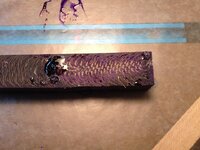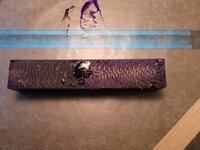Russknan
Member
OK, here is my third and last thread - for awhile, anyway. I don't want to be clogging up the forum. I have been looking around for other things to imbed in Alumalite. In this regard, I suggested that my wife not hang around my bench for any length of time! She's very well preserved, in my opinion, but may not want to see how she looks in resin . . . !
Anyway, I wanted to cast some pine cones in a blank. I gathered some, put them in my dehydrator for a couple of days . . . and discovered that the heat caused the pine cones to open up to a size where they wouldn't fit into the mold. So I got some somewhat smaller ones, just stuck them in the mold, and had at it. When I took it out of the pressure pot, there was liquid bubbling out of some spots, and the top of the blank was gummy. I left it overnight, blotted up some of the gummy stuff, and cut the top off the blank. I really like the way it looks, even though there are some voids. And most of the blank seems solid.
So I left it for another day or two. Today, when I got back into the shop, there was some more liquid, as you can see in the pictures. I'm hoping the more experienced folks here can help. Do you think this blank is toast, or is there a possible treatment? If I can't fix it, it's not the end of the world. We have plenty more pine cones in the neighborhood, but I DO like the preliminary look at this blank.
I'm thinking that, in the future, I might jam a couple of pine cones into the mold, make some turns with twine around the whole business to keep the cone from expanding, and putting the mold upside down in the dehydrator for a couple of days before casting. Am I on the right track? Russ
Anyway, I wanted to cast some pine cones in a blank. I gathered some, put them in my dehydrator for a couple of days . . . and discovered that the heat caused the pine cones to open up to a size where they wouldn't fit into the mold. So I got some somewhat smaller ones, just stuck them in the mold, and had at it. When I took it out of the pressure pot, there was liquid bubbling out of some spots, and the top of the blank was gummy. I left it overnight, blotted up some of the gummy stuff, and cut the top off the blank. I really like the way it looks, even though there are some voids. And most of the blank seems solid.
So I left it for another day or two. Today, when I got back into the shop, there was some more liquid, as you can see in the pictures. I'm hoping the more experienced folks here can help. Do you think this blank is toast, or is there a possible treatment? If I can't fix it, it's not the end of the world. We have plenty more pine cones in the neighborhood, but I DO like the preliminary look at this blank.
I'm thinking that, in the future, I might jam a couple of pine cones into the mold, make some turns with twine around the whole business to keep the cone from expanding, and putting the mold upside down in the dehydrator for a couple of days before casting. Am I on the right track? Russ


